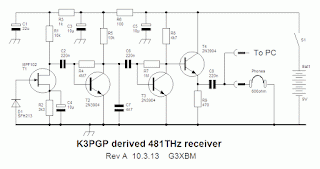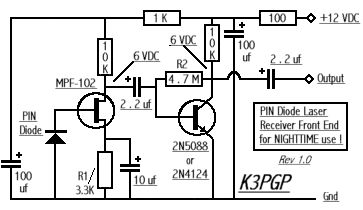This evening, in the freezing cold, I attempted a non line-of-sight (NLOS) optical test using my beacon TX (1W 10mm LED at 250mA in 100mm optics) at home in the bedroom firing out through the double glazed bedroom window and my new improved receiver (SFH213 detector in 100mm optics) at a new test site 4.6km away towards Cambridge. The path is obstructed by rising ground some 10m above the TX and RX height around mid path.
 |
| 481THz signal (top line) at 4.6km over the horizon tonight |
This time, I used a lower TX subcarrier tone frequency of 572.3Hz and a continuous carrier transmission so that aiming would be easier (!) than with CW or QRSS3. I am pleased to report successful reception of the signal in 84mHz bandwidth using Spectran, but aim was extremely critical and the signal was not solid, probably because of aiming issues and possibly changing sky conditions.
When I got home I checked the frequency to make absolutely sure that this was my carrier, which it was beyond any doubt. The signal was totally inaudible in the headphones and there was no sign whatsoever of the red beam in the sky. The most probable propagation was by scatter off dust particles in the atmosphere.
This was MUCH harder than I expected: I honestly expected to hear quite reasonable signals by ear, but as the plot shows, the signal was only just copyable in 84mHz. When I received my signal NLOS last year at 3.5km on a different path signals were 10dB over noise in a wider bandwidth on QRSS3.
At the moment I am still aiming the TX and RX as low as possible on the horizon, but I need to try greater elevations to see if this gives better to worse results over this sort of distance.
Another 6-10dB ERP from the Phlatlight LEDs (still to be fired up) would certainly help.










